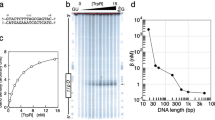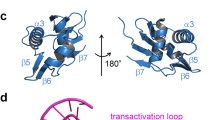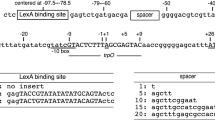Summary
We have studied the importance of the specific DNA sequence of the deo operator site for DeoR repressor binding by introducing symmetrical, single basepair substitutions at all positions in the deo operator and tested the ability of these variants to titrate DeoR in vivo. Our results show that a 16 by palindromic sequence constitutes the deo operator. Positions outside this palindrome (positions ±9, ±10) can be changed without any major effect on DeoR binding. Most of the central 6-8 by of the palindrome (positions ±1, ±2, ± 3) can be substituted with other nucleotides with no or only minor effects on DeoR binding, while changes at position ±4 and ±_5 give a more heterogeneous response. Finally, changes at positions ±6, ± 7 and ±8 severely disrupt DeoR binding.
Similar content being viewed by others
References
Amouyal M, Mortensen L, Buc H, Hammer K (1989) Single and double loop formation when deoR repressor binds to its natural operator sites. Cell 58:545–551
Bech L (1991) Regulation of transcription initiation: Characterization of the DeoR repressor and DeoR-DNA interactions. PhD thesis, Uversity of Copenhagen
Bremer E, Middendorf A, Martinussen J, Valentin-Hansen P (1990) Analysis of the tsx gene, which encodes a nucleoside-specific channel-forming protein (Tsx) in the outer membrane of Escherichia coli. Gene 96:59–65
Buxton RS (1979) Fusion of the lac genes to the proximal promoters of the deo operon of Escherichia coli. J Gen Microbiol 112:241–250
Clark DJ, Maaløoe O (1967) DNA replication and the division cycle of Escherichia coli. J Mol Biol 23:99–112
Dandanell G (1992) DeoR repression at a distance only weakly responds to changes in interoperator separation and DNA topology. Nuc Acids Res 20:5407–5412
Dandanell G, Hammer K (1985) Two operator sites separated by 599 base pairs are required for DeoR repression of the deo operon of Escherichia coli. EMBO J 4:3333–3338
Dandanell G, Hammer K (1990) In vivo CRP-CAMP regulation of the deoP1 and deoP2 promoters of E. coli K12. Molecular Genetics (Live Sci Adv) 9:41–45
Dandanell G, Hammer K (1991) deoP1 promoter and operator mutants in Escherichia coli: Isolation and characterization. Mol Microbiol 5:2371–2376
Dandanell G, Norris K, Hammer K (1991) Long distance deoR regulation of gene expression in E. coli. Ann New York Acad Sci 646:19–30
Dandanell G, Valentin-Hansen P, Løve-Larsen PE, Hammer K (1987) Long-range cooperativity between gene regulatory sequences in a prokaryote. Nature 325:823–826
Davis T, Yamada M, Elgort M, Saier MH (1988) Nucleotide sequence of the mannitol (mtl) operon in Escherichia coli. Mol Microbiol 2:405–412
Gicquel-Sanzey B, Cossart P (1982) Homologies between different procaryotic DNA-binding regulatory proteins and between their sites of action. EMBO J 1:591–595
Hammer K, Dandanell G (1989) The deoR repressor from E. coli and its action in regulation-at-distance. In: Eckstein F, Lilley DMJ (eds) Nucleic acids and molecular biology. Springer-Verlag, Berlin- Heidelberg, pp 79–91
Hammer-Jespersen K (1983) Nucleoside catabolism. In: MunchPetersen A (ed) Metabolism of nucleotides, nucleosides and nucleobases in microorganisms. Academic Press, London, pp 203–258
Johnston F, Ponnambalam S, Busby S (1987) Binding of Escherichia coli RNA polymerase to a promoter carrying mutations that stop transcription initiation. J Mol Biol 195:745–748
Koudelka GB, Harrison SC, Ptashne M (1987) Effect of non-contacted bases on the affinity of 434 operator for 434 repressor and cro. Nature 326:886–888
Kriger-Brauer HJ, Braun V (1980) Functions related to the receptor protein specified by the tsx gene of Escherichia coli. Arch Microbiol 124:233–242
Maniatis T, Fritsch EF, Sambrook J (1982) Molecular cloning: a laboratory manual. Cold Spring Harbor Laboratory Press, Cold Spring Harbor, New York
Miller JH (1972) Experiments in molecular genetics. Cold Spring Harbor Laboratory Press, Cold Spring Harbor, New York
Mortensen L, Dandanell G, Hammer K (1989) Purification and characterization of the DeoR repressor of Escherichia coli. EMBO J 8:325–331
Munch-Petersen A, Jensen N (1990) Analysis of the regulatory region of the Escherichia coli nupG gene, encoding a nucleosidetransport protein. Eur J Biochem 190:547–551
Munch-Petersen A, Mygind B (1983) Transport of nucleic acid precursors. In: Munch-Petersen A (ed) Metabolism of nucleotides, nucleosides and nucleobases in microorganisms. Academic Press, London, pp 259–305
Munch-Petersen A, Nygaard P, Hammer-Jespersen K, Fiil N (1972) Mutants constitutive for nucleoside-catabolizing enzymes in Escherichia coli K12. Isolation, characterization and mapping. Eur J Biochem 27:208–215
Oskouian B, Stewart GC (1990) Repression and catabolite repression of the lactose operon of Staphylococcus aureus. J Bacteriol 172:3804–3812
O'Callaghan CH, Morris A, Kirby SM, Shingler AH (1972) Novel method for detection of β-lactamase by using a chromogenic cephalosporin substrate. Antimicrob Agents Chemother 1:283–288
Pabo CO, Sauer RT (1984) Protein-DNA recognition. Ann Rev Biochem 53:293–321
Ponnambalam S, Webster C, Birgham A, Busby S (1986) Transcription initiation of the Escherichia coli galactose operon promoters in the absence of normal — 35 regions sequences. J Biol Chem 261:16043–16048
Rooijen RJ van, Vos WM de (1990) Molecular cloning, transcriptional analysis and nucleotide sequence of lacR, a gene encoding the repressor of the lactose phosphotransferase system of Lactococcus lactis. J Biol Chem 165:18499–18503
Silhavy TJ, Berman ML, Enquist LW (1984) Experiments with gene fusions. Cold Spring Harbor Laboratory Press, Cold Spring Harbor, New York
Valentin-Hansen P, Aiba H, Schümperli D (1982) The structure of tandem regulatory regions in the deo operon of Escherichia coli K12. EMBO J 1:317–322
Valentin-Hansen P, Albrechtsen B, Larsen JEL (1986) DNA-protein recognition: demonstration of three genetically separated operator elements that are required for the repression of the Escherichia coli deoCABD promoters by the DeoR repressor. EMBO J 5:2015–2021
Author information
Authors and Affiliations
Additional information
Communicated by H. Hennecke
Rights and permissions
About this article
Cite this article
Hammer, K., Bech, L., Hobolth, P. et al. DNA specificity of Escherichia coli deoP1 operator-DeoR repressor recognition. Molec. Gen. Genet. 237, 129–133 (1993). https://doi.org/10.1007/BF00282793
Received:
Accepted:
Issue Date:
DOI: https://doi.org/10.1007/BF00282793




